Large variety of carrots Red giant
Among the variety of carrot varieties, the Red Giant variety stands out due to its yield and sweetness. It is grown in all regions of Russia. Carrots are well known for their size and versatility. What else are its features and advantages - you will find out further.
The content of the article
- Description of the variety Red giant
- Chemical composition, trace elements and vitamins, useful properties
- The main advantages and disadvantages of the variety
- Features of planting and growing
- Harvesting and storage
- What can be the difficulties in growing
- Tips from experienced gardeners
- Reviews of the Red Giant carrot variety
- Conclusion
Description of the variety Red giant
The red giant is a mid-season variety. When planted in May, the crop is harvested in August. The variety has high yield rates. It is distinguished by large, sweet roots.
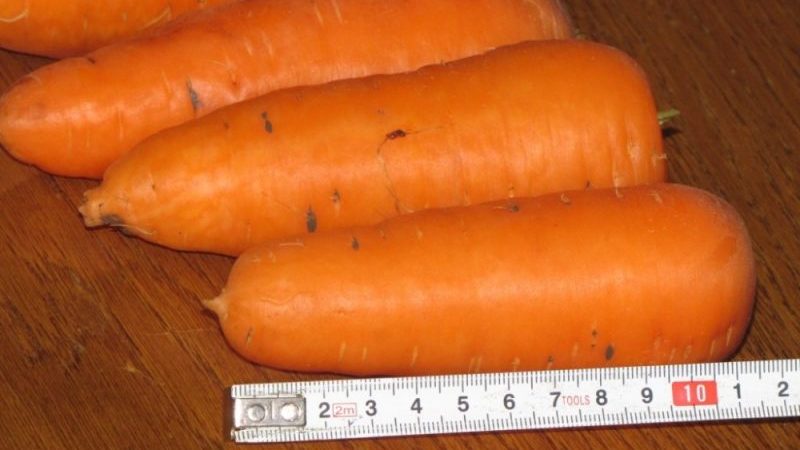
Origin and development
The red giant is one of the newer varieties of carrots. Its breeding was carried out by employees of the Moscow LLC "AGROFIRMA AELITA". The variety was included in the state register in 2015. It is recommended for cultivation in the Central region of Russia, but its real geography covers almost the entire country.
Chemical composition, trace elements and vitamins, useful properties
The Red Giant variety is characterized by a high content vitamins, micro and macro elements. 100 g of carrots contains fructose - 17-21 mg, carotene - 8-9%.
Macronutrients:
- potassium - 205 mg;
- calcium - 22.7 mg;
- phosphorus - 44 mg;
- magnesium - 35.8 mg;
- sodium - 16.2 mg;
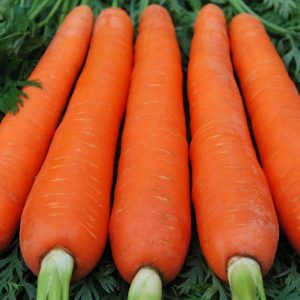
- sulfur - 4.7 mg.
Trace elements:
- iron - 0.9 mg;
- zinc - 0.33 mg;
- aluminum - 0.2 mg;
- manganese - 0.22 mg;
- boron - 0.21 mg;
- copper - 0.68 mg;
- fluorine - 0.45 mg.
Vitamins:
- A - 0.93 mg;
- B1 - 0.06 mg;
- B2 - 0.05 mg;
- B9 - 0.14 mg;
- C - 0.46 mg;
- PP - 1.23 mg;
- E - 0.76 mg.
Carrots are certainly good for the human body. Eating a vegetable has a beneficial effect on vision, the immune system, and metabolic processes. Carrots help eliminate intestinal dysbiosis, normalize the gastrointestinal tract, improve the state of blood vessels.
Application features
The red giant is intended for cultivation in personal subsidiary plots. The variety is versatile in application... Preparation of first courses and various culinary products. Juices and vegetable purees for children are made from juicy fruits.
Ripening period and yield
The variety belongs to mid-season - full ripening occurs 100-110 days after planting the seeds.
The yield of the variety is quite high: from 1 sq. m collect 4-6 kg of carrots.
Disease resistance
The variety has high resistance to powdery mildew, brown spot, bacteriosis. It resists the attacks of the beetle, the umbrella moth.
Characteristics and description of the appearance of the bush, fruit, taste
The variety has a high, spreading rosette of rich green leaves dissected along the edges. Root crops are red-orange in color, in the form of an oblong cone with a blunt tip. Their length reaches 25 cm, width at the base is 6 cm.The average weight is 120-150 g.The heart is medium in size, the flesh is juicy and sweet.
For which regions it is best suited and what is the exacting climate
The variety is frost-resistant, suitable for growing in almost all regions of Russia.
The main advantages and disadvantages of the variety
The advantages of the variety include: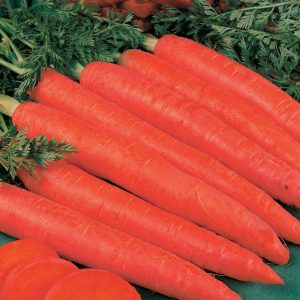
- high productivity;
- sugar taste and juiciness;
- cold resistance, the possibility of sowing before winter;
- long shelf life;
- high resistance to many diseases and pests.
The disadvantage of the variety is the average resistance to carrot fly damage.
What is the difference from other varieties
Carrots differ from other varieties:
- large size;
- tolerates small frosts well;
- vegetables are not prone to cracking.
Features of planting and growing
Red giant carrots are cold-resistant varieties, so they can be sown before winter in early November. When planting in winter, the beds are insulated with sawdust, straw.
Preparing for landing
For best germination, seeds require preparation before planting. First, the seeds are soaked in a container of water for two hours. During this time, high-quality seeds will settle to the bottom, unsuitable ones will float up - they are thrown away.
The remaining seeds are disinfected in a weak solution of potassium permanganate for an hour, washed with water. Then they are laid out between layers of damp cloth and germinated for 6-7 days in a warm place. The cloth can be moistened with growth stimulants "Zircon", "Epin", diluted in the amount of 4 drops per 1 liter of warm water.
Important! When planting in winter, the seeds do not germinate.
Ground requirements
For planting varieties, choose a site with loamy, sandy loam soil. The soil should be loose, it is good to let moisture and air pass to the roots. The plot is prepared in the fall, carefully removing plant debris and stones. Then, deep digging is carried out with the simultaneous introduction of organic matter, charcoal, complex mineral fertilizers.
Predecessors
The best predecessors of carrots: potatoes, legumes, cucumbers, tomatoes, cabbage.
Attention! Carrots are not recommended to be planted after beets, dill, parsley, celery.
Timing, scheme and landing rules
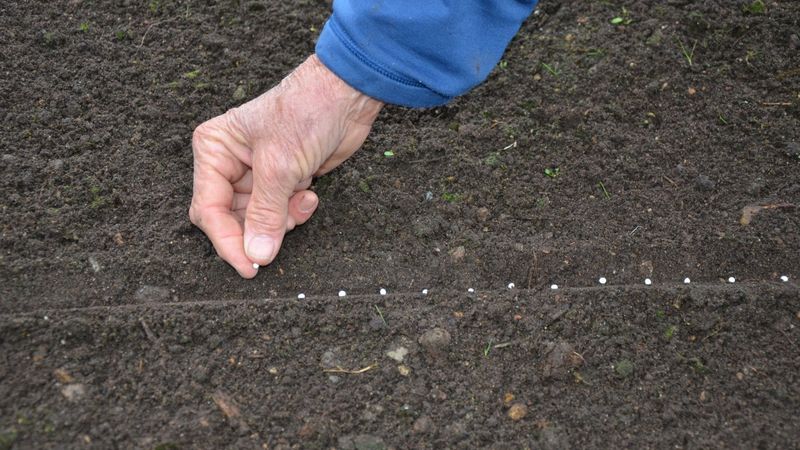
Sprouted seeds are planted in open ground in late April - early May, when the soil warms up to + 7 ... + 9 ° С. In the prepared area, grooves are made with a depth of 1.5-2 cm, they are watered with warm water. A distance of 18-20 cm is maintained between the rows.
Seeds are placed at a distance of 2 cm. The seed grooves are sprinkled with a thin layer of earth, lightly tamped.
Reference. Planting seeds before winter is carried out in late October - early November, when the soil temperature drops to + 5 ° C.
Growing features
For planting crops, a sunny site is chosen, since seedlings grow much slower in the shade, root crops are not formed sufficiently large and less sweet.
The variety forms long root crops, therefore, when choosing a site, first check for the presence of closely lying groundwater. In waterlogged areas, root crops will begin to rot.
The nuances of care
To preserve seedlings from recurrent frosts, the beds are first covered with a transparent film until the shoots appear.
After the emergence of seedlings, the soil is loosened, preventing the formation of an earthen crust, while removing rapidly growing weeds.
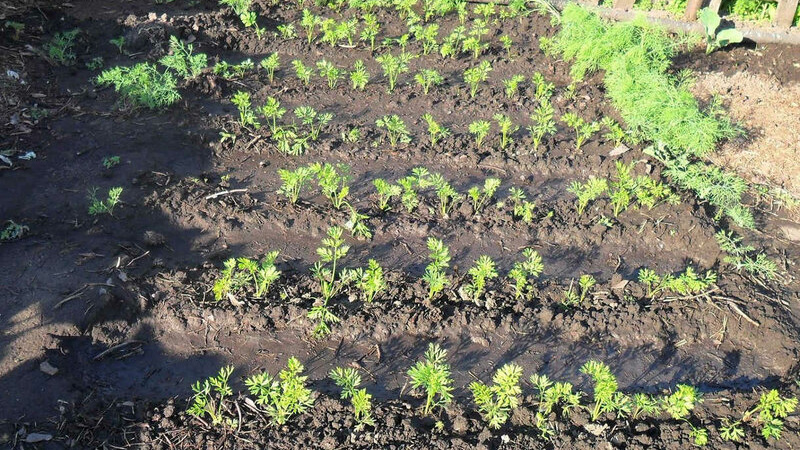
Watering mode
When seedlings appear, the beds are watered twice a week. During severe drought, drip irrigation is additionally used. Watering is carried out in the morning and evening hours. When forming root crops, the beds are watered once a week. As the vegetables grow, the fluid volume increases. Watering should be carried out regularly - with long breaks, carrots can crack.
Important! It is recommended to stop watering 2-3 weeks before harvesting.
Thinning and weed control
Much attention is paid to thinning. In thickened plantings, the fruits will be small. The first thinning is carried out when the seedlings reach 8-10 cm.The weakest shoots are removed, while the distance between shoots increases.
The second time the culture is thinned out during the formation of root crops, increasing the distance between the bushes to 3-4 cm.
As vegetables grow, thinning is repeated, removing less developed specimens. The distance between the grown bushes should be at least 7-8 cm.
Removal of weeds is carried out during the entire growth of the crop until the moment of harvest. Weed grass depletes the soil, carrot bushes will grow weakened. Therefore, much attention is paid to weeding.
Top dressing
Two weeks after emergence, complex fertilizers are applied... Prepare the following composition: 15 g of double superphosphate, 20 g of urea, 20 g of potassium nitrate per 10 liters of water.
During the formation of fruits, a top dressing is applied, consisting of 15 g of potassium sulfate, 20 g of superphosphate per 10 liters of water.
A month before the carrots are fully ripe, boron and manganese are added to improve the taste: 2 g of potassium permanganate, 5 g of boric acid are diluted in 10 liters of water. Ash dressings are also used: a glass of ash is insisted for 3-4 days in 10 liters of water.
Attention! Before fertilizing, the plants are watered with a small amount of clean water.
Disease and pest control
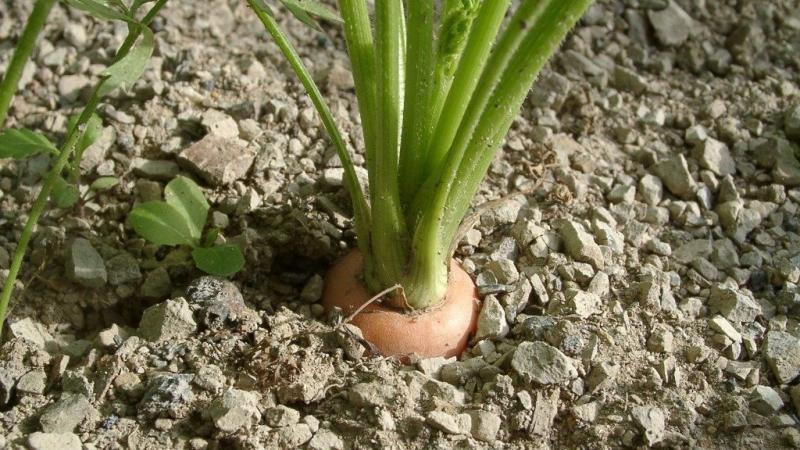
The variety has good immunity to diseases, but if agricultural technology is violated, some illness.
Alternaria (black rot)
The first sign of the disease is the appearance of dark brown spots on the leaves. On young shoots, the tops turn black. Dry black rot appears on root crops. You can get rid of black rot with the help of the preparations "Rovral", "Falcon".
For prophylaxis, in the spring, before sowing seeds, the site is treated with a 1% solution of Bordeaux liquid.
Phomoz (dry rot)
Fungal damage to the plant. First, the fungus appears on the tops, the leaves are covered with red-brown spots, then dry out. After that, the disease passes to the root crop, forming gray spots on it, in which the process of decay begins.
To prevent the disease, the plots are fertilized with potash compounds, the plants are sprayed with a 1% solution of Bordeaux liquid. At the initial stages of the disease, a solution of the drug "Maxim" (1: 1) is used.
White rot
Affects root crops during storage. They become soft, covered with a white fluffy bloom, and gradually rot. White rot spreads through contaminated soil, so the beds are treated with copper-based preparations (copper sulfate, Bordeaux liquid).
Carrot plantings are attacked by wireworms. The pest feeds on root crops, gnawing numerous passages in it. The plant lags behind in growth, the tops wither, the roots cannot be stored and eaten. Traps are used to destroy the wireworm, and green manures are planted. The soil is treated with drugs "Aktara", "Bazudin".
The carrot fly lays eggs on the leaves. The larvae that appear destroy the tops. The plant dries up... When pests appear, the bushes are sprinkled with ash and tobacco. When breeding insects, the drug "Intavir" is used.
Harvesting and storage
The red giant belongs to the mid-season varieties, so the harvest is carried out in August. When sowing in winter, the roots are harvested in July.
How and when to collect
As soon as the lower leaves of the tops turn yellow, harvesting begins.
Carrots are pulled out of the ground by holding on to the tops. Use a shovel or pitchfork if necessary. Root crops are cleaned of the ground by tapping them on the ground, the tops are cut with a knife or twisted.
After that, the carrots are laid out on a dry surface in a room to dry. After 4-5 days, it is sorted: damaged vegetables are taken for processing. Good roots are transferred to storage.
Storage features and keeping quality of the variety
A microclimate is created in the vegetable store with an air temperature of + 1 ... + 4 ° C, humidity in the store within 87-90%. The room must be constantly ventilated. Subject to the recommended storage rules, the keeping quality of the variety reaches 97%.
What can be the difficulties in growing
So that the base of the roots does not rise above the soil, the beds are slightly raised. This should be done after watering, when the water erodes the soil.
When applying nitrogen fertilizing, it is important to correctly calculate the amount of nitrogen. Its increased content in the soil leads to increased growth of tops to the detriment of the formation of root crops.
Tips from experienced gardeners
Experienced gardeners advise, during autumn planting, to plant seeds in the ground to a depth of at least 3 cm.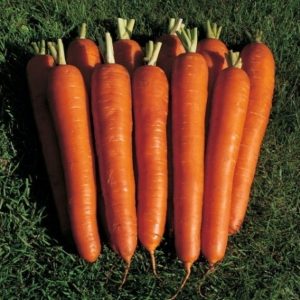
To prevent thickening of carrot plantings, vegetable growers recommend buying seeds on a belt. Producers immediately fix the seeds at the correct distance on the belt. The beds with such seeds must be loosened regularly so that a soil crust does not form.
Gardeners recommend diluting it with sand or peat in the presence of heavy soil on the site.
Also, experienced summer residents advise using drip irrigation when shoots appear. This will prevent the water pressure from washing the seeds out of the soil when watering.
Reviews of the Red Giant carrot variety
Reviews of the variety are mostly positive.
Nina, Ryazan: «I tried to plant Red Giant carrots, first in the fall, then in the spring. Autumn shoots appeared two weeks earlier. They grew up equally amicably. I liked the harvest, the fruits are even, there were no small ones. The carrots are delicious and crispy. "
Irina, Tula: “I have been planting the Red Giant variety for two years in a row. There were no problems in growing and leaving. She kept the harvest in the cellar in a box of sand. Until the very spring I got dense, flabby, crispy vegetables. "
Oleg, Omsk: “I bought the variety on the advice of the seller. I liked the germination of seeds. During cultivation, I did not make much effort, the main thing is to thin out and remove weeds in time. Harvested in mid-September. The carrots have grown smooth, very tasty and sweet. "
Conclusion
Farmers and summer residents loved the Red Giant variety for its large, juicy and tasty fruits. The variety is unpretentious to care for, it is grown in areas with different climatic conditions. Carrots keep well during the winter. If desired, you can carry out the autumn planting of carrots.